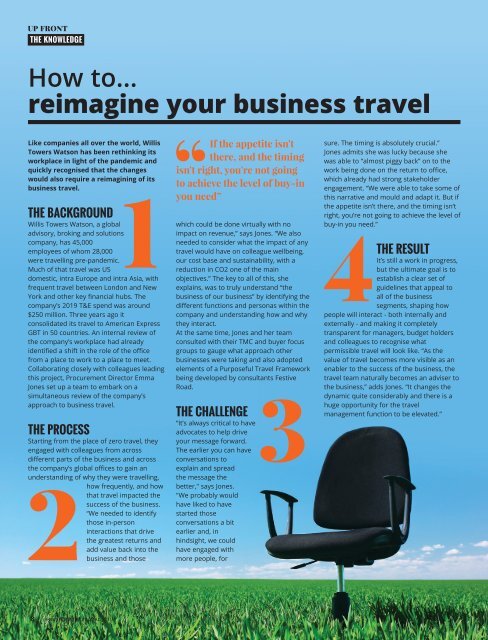Business Travel March-April-2021
You also want an ePaper? Increase the reach of your titles
YUMPU automatically turns print PDFs into web optimized ePapers that Google loves.
ARRIVALS<br />
UP FRONT<br />
THE KNOWLEDGE<br />
How to...<br />
reimagine your business travel<br />
Like companies all over the world, Willis<br />
Towers Watson has been rethinking its<br />
workplace in light of the pandemic and<br />
quickly recognised that the changes<br />
would also require a reimagining of its<br />
business travel.<br />
THE BACKGROUND<br />
Willis Towers Watson, a global<br />
advisory, broking and solutions<br />
company, has 45,000<br />
employees of whom 28,000<br />
were travelling pre-pandemic.<br />
Much of that travel was US<br />
domestic, intra Europe and intra Asia, with<br />
frequent travel between London and New<br />
York and other key financial hubs. The<br />
company’s 2019 T&E spend was around<br />
$250 million. Three years ago it<br />
consolidated its travel to American Express<br />
GBT in 50 countries. An internal review of<br />
the company’s workplace had already<br />
identified a shift in the role of the office<br />
from a place to work to a place to meet.<br />
Collaborating closely with colleagues leading<br />
this project, Procurement Director Emma<br />
Jones set up a team to embark on a<br />
simultaneous review of the company’s<br />
approach to business travel.<br />
THE PROCESS<br />
Starting from the place of zero travel, they<br />
engaged with colleagues from across<br />
different parts of the business and across<br />
the company’s global offices to gain an<br />
understanding of why they were travelling,<br />
how frequently, and how<br />
that travel impacted the<br />
success of the business.<br />
“We needed to identify<br />
those in-person<br />
interactions that drive<br />
the greatest returns and<br />
add value back into the<br />
business and those<br />
If the appetite isn't<br />
there, and the timing<br />
isn't right, you're not going<br />
to achieve the level of buy-in<br />
you need”<br />
which could be done virtually with no<br />
impact on revenue,” says Jones. “We also<br />
needed to consider what the impact of any<br />
travel would have on colleague wellbeing,<br />
our cost base and sustainability, with a<br />
reduction in CO2 one of the main<br />
objectives.” The key to all of this, she<br />
explains, was to truly understand “the<br />
business of our business” by identifying the<br />
different functions and personas within the<br />
company and understanding how and why<br />
they interact.<br />
At the same time, Jones and her team<br />
consulted with their TMC and buyer focus<br />
groups to gauge what approach other<br />
businesses were taking and also adopted<br />
elements of a Purposeful <strong>Travel</strong> Framework<br />
being developed by consultants Festive<br />
Road.<br />
THE CHALLENGE<br />
“It’s always critical to have<br />
advocates to help drive<br />
your message forward.<br />
The earlier you can have<br />
conversations to<br />
explain and spread<br />
the message the<br />
better," says Jones.<br />
"We probably would<br />
have liked to have<br />
started those<br />
conversations a bit<br />
earlier and, in<br />
hindsight, we could<br />
have engaged with<br />
more people, for<br />
sure. The timing is absolutely crucial.”<br />
Jones admits she was lucky because she<br />
was able to “almost piggy back” on to the<br />
work being done on the return to office,<br />
which already had strong stakeholder<br />
engagement. “We were able to take some of<br />
this narrative and mould and adapt it. But if<br />
the appetite isn’t there, and the timing isn’t<br />
right, you’re not going to achieve the level of<br />
buy-in you need.”<br />
THE RESULT<br />
It’s still a work in progress,<br />
but the ultimate goal is to<br />
establish a clear set of<br />
guidelines that appeal to<br />
all of the business<br />
segments, shaping how<br />
people will interact - both internally and<br />
externally - and making it completely<br />
transparent for managers, budget holders<br />
and colleagues to recognise what<br />
permissible travel will look like. “As the<br />
value of travel becomes more visible as an<br />
enabler to the success of the business, the<br />
travel team naturally becomes an adviser to<br />
the business,” adds Jones. “It changes the<br />
dynamic quite considerably and there is a<br />
huge opportunity for the travel<br />
management function to be elevated.”<br />
8 THEBUSINESSTRAVELMAG.COM

















